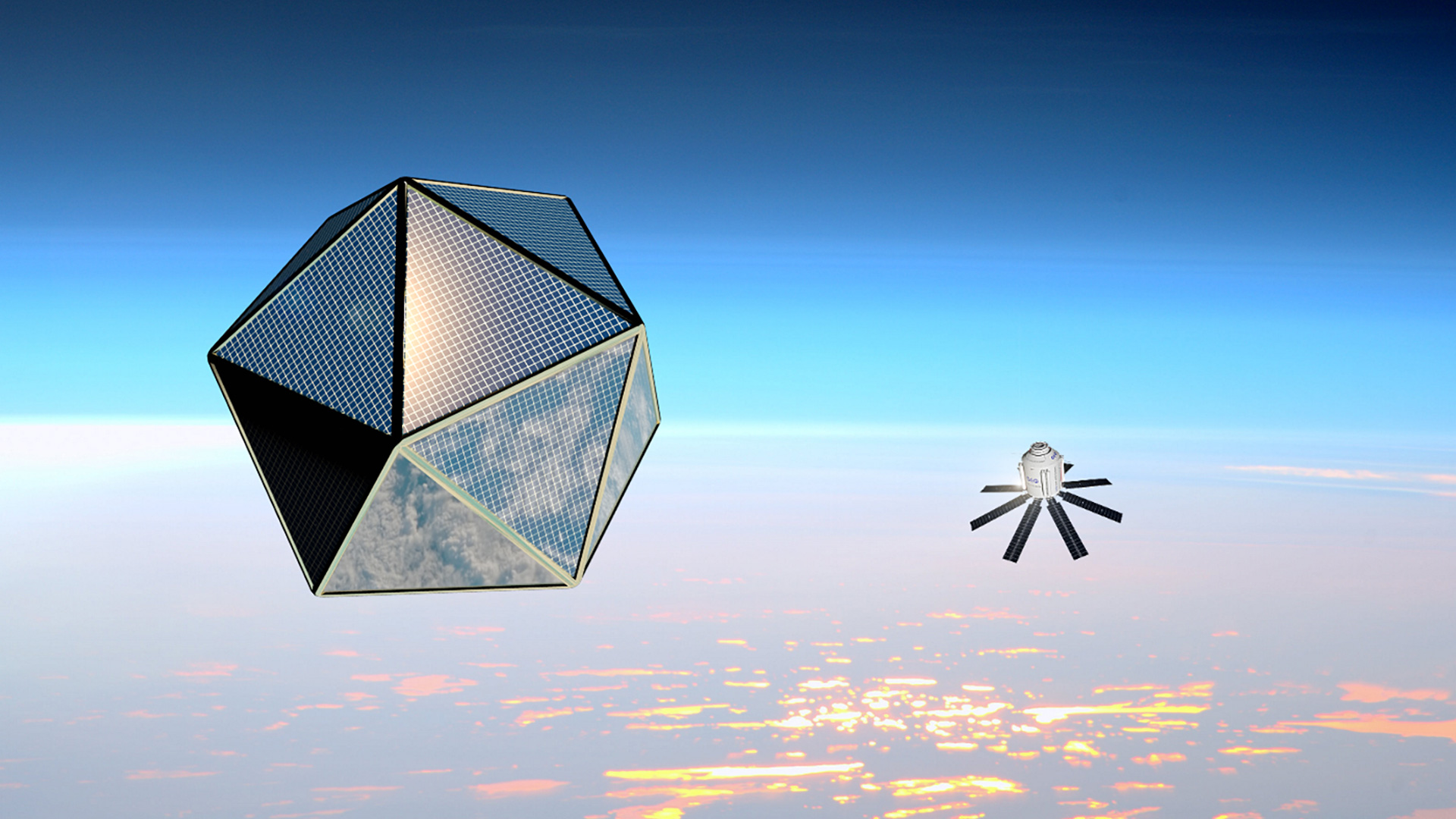Space Option Star: F.A.Q. - Frequently Asked Questions

Please study all of the pages on this website for a comprehensive overview of the Space Option Star project.
Here are some frequently asked questions and answers.
- What is the Space Option Star?
The Space Option Star will utilize an inflatable laminated membrane technology incorporating a thin-film photovoltaic outer surface. Once in orbit, the reflective, faceted shape of the Space Option Star will reflect sunlight as it rotates causing it to appear as a blinking star in the night sky for a period of approximately one month or longer. In addition to the visibility aspects, interactive components will enable communication with Space Option Star at public locations around the world such as art and science museums and schools. The technical mission of the Space Option Star will be to collect sunlight, transform it into energy and then to transmit this energy via a concentrated beam to provide power for an auxiliary, unattached object in orbit which will then use this power to communicate with locations on the Earth.
- What is the purpose of the Space Option Star mission?
As stated on the SOS Mission page the Space Option Star has two main objectives:
First, as communication, its mission is to alert and inform the world population about the Energy Dilemma and to call attention to the Space Energy Option.
Second, its technical mission represents an early in-situ demonstration of Wireless Power Transmission (WPT) a key element of Space-Based Solar Power (SBSP) which should help to justify its development cost.
- Will the Space Option Star beam energy to Earth?
No, the SOS will collect energy in space and use a microwave transmitter to convert the sunlight into electricity and then transmit electrical power to an auxiliary spacecraft which will use the received power to interactively communicate with stations located on Earth. As such, it will be an early “in space” or in-situ demonstration of the basic technological concepts of Space Solar Power.
- What is the significance of this demonstration?
If realized within the next decade, the SOS will probably be the largest structure ever deployed or built in outer space, and, that it will be visible to much of the world’s population, will make SOS an unprecedented space event. In addition, the interactive communication from the spacecraft to locations on Earth will involve people from around will be highly educational. Last but not least, the art funding approach will allow the world population to personally share in its realization.
If successful, this mission could stimulate further development in the Space-Based Solar Power technology which could eventually help address energy and climate issues on Earth.
There exists a big commercial potential to supply satellites and space stations with electrical power instead of each spacecraft having its own solar power collectors. This could reduce to overall cost of producing spacecraft while increasing their reliability. The SOS would be an early demonstration of Wireless Power Transmission (WPT)
- How can Space Solar Power realistically contribute to addressing humanity’s energy and climate issues?
Solar power does not produce CO2. Harnessing solar energy in space would replace humanity’s dependence on its continued use of finite fossil fuels which are also environmentally negative and likewise, on the widespread use nuclear fuels which have grave environmental and geopolitical aspects. Unfortunately, it appears that alternative and renewable terrestrial energy resources, while both desirable and necessary, cannot be scaled adequately and thus economically deployed on a scale sufficient to meet the growing needs and demands of present and future populations.
- Why is it called a “star” and will it be visible to observers on Earth?
As presently defined, the Space Option Star will have a diameter of approximately 100 meters and will be a highly reflective spherical object. Its rotation will reflect sunlight in a blinking fashion.
In comparison, the International Space station - which is an irregularly shaped object - is approximately 52 m long, 27.4 m high and 73 m wide and is easily visible to the naked eye.
- Is the Space Option Star technologically feasible?
The underlying technology of using CRES (Chemically Rigidized Expandable Structures) for large space structures has been under development in Europe and in the United Stated for almost thirty years, although not yet used for a space object of this dimension. The authors have a long experience with proposing artworks based on this technology and carried out a study sponsored by the European Space Agency in 2003 that provided a basis for the current technological SOS (icosahedron) definition. A number of international studies and experiments have explored the idea of power generation in space and the wireless transmission of power. Please see the Videos, Books and Energy from Space Headlines sections for more information.
- How much will the Space Option Star cost?
The actual cost of the mission can only be determined once additional technical studies have been carried out. These are part of the project’s development plan. At the moment, the Space Option Star will have an estimated mass of 3,500 kilograms, a main cost factor will be the actual launch costs. Recent developments have seen a reduction in launch costs.
Based on our best estimates and experience we believe the project could be realized for 25 -50 million Swiss francs (Swiss francs are approximately equivalent to US dollars).
